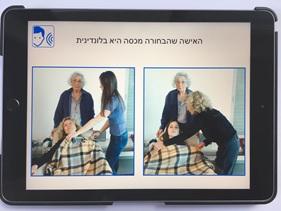Background
-
Aphasia is an impairment of language, affecting speech and comprehension of speech and the ability to read and write and is the result of damage to the brain, most commonly from stroke (could also occur due to head trauma, brain tumors or infections).
-
21%-28% of stroke patients will suffer from aphasia which is associated with higher mortality, morbidity and utilization of healthcare resources.
-
Low intensity treatments of aphasia (2-3 hours/week, for 8 weeks) results in little improvement while high intensity treatment (8-9 hours/week, for 11 weeks) results in significant effects. That, together with the impracticality of supporting that increase in therapist time requires a simple to use, self-treatment tool.
Our Innovation
The research group developed a tablet-based, patient operated device offering dynamic diagnosis and therapy of language comprehension disorders. The tool evaluates and classifies type and severity of language impairment and generates a treatment plan through an iterative process.
The Advantages
-
Automatic and self-operated, at the home setting.
-
Therapy is evidence based.
-
Therapy evolves based on the patient’s progress and is personalized.
-
Modular – simple to add new modules and Languages to support additional settings.
-
Well founded on science and knowhow accumulated over years of research in linguistics and neuroscience.

Fig. 1: Tablet Mounted Self-Operated App
Opportunity
The technology addresses a large market:
-
Cost, per patient, attributable specifically to Aphasia, in post stroke patients is estimated at $2,000
-
The technology taps this market by addressing the gap in the health system’s ability to provide the required treatment for patients with language comprehension disorders and by facilitating the rehabilitation of these patients.
